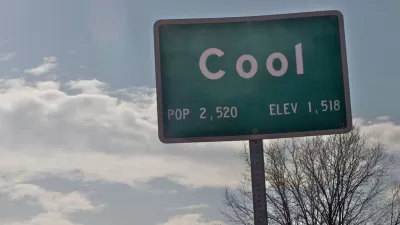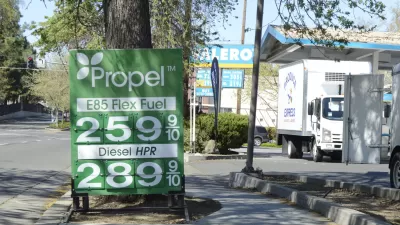California's embattled high speed rail, which appears to be on life support following a Nov. court ruling, will receive funds from the state's carbon cap & trade program in Gov. Brown's budget to be released Friday. But will it make a difference?
"Gov. Jerry Brown plans to propose spending millions of dollars in fees paid by carbon producers to aid the state's controversial high-speed rail project," writes political reporter Christopher Cadelago.
Brown is expected to include the proposal in the annual budget plan he will release Friday (Jan.10). Brown has made high-speed rail a priority of his administration, and he suggested two years ago that cap-and-trade revenue, which is designed to reduce greenhouse gas emissions, would be a future source of funding for the project.
According to the Sacramento Bee's sources, it could be "several hundred million dollars this year."
But the use of cap-and-trade money for high-speed rail could be problematic. The nonpartisan Legislative Analyst’s Office (LAO) said in 2012 that while the rail project could eventually help reduce greenhouse gas emissions, benefits would not be seen until after 2020, the year by which California is seeking to meet its greenhouse gas reduction goals (according to the law that set that goal, AB 32).
Notwithstanding the possible deathblow of a legal ruling in late November followed by a major setback issued by the Surface Transportation Board, the High Speed Rail Authority is plowing forward, using eminent domain to acquire properties in downtown Fresno, though not without opposition.
Thanks to several factors, including an upturn in the economy and the passage of Brown's signature tax initiative, Proposition 30, in Nov., 2012, the LAO "projected last fall that the state could post a $5.6 billion surplus by June 2015, with annual surpluses reaching $8.3 billion by the 2016-17 budget year."
FULL STORY: Jerry Brown eyes cap-and-trade money for high-speed rail

Alabama: Trump Terminates Settlements for Black Communities Harmed By Raw Sewage
Trump deemed the landmark civil rights agreement “illegal DEI and environmental justice policy.”

Study: Maui’s Plan to Convert Vacation Rentals to Long-Term Housing Could Cause Nearly $1 Billion Economic Loss
The plan would reduce visitor accommodation by 25% resulting in 1,900 jobs lost.

Planetizen Federal Action Tracker
A weekly monitor of how Trump’s orders and actions are impacting planners and planning in America.

Wind Energy on the Rise Despite Federal Policy Reversal
The Trump administration is revoking federal support for renewable energy, but demand for new projects continues unabated.

Passengers Flock to Caltrain After Electrification
The new electric trains are running faster and more reliably, leading to strong ridership growth on the Bay Area rail system.

Texas Churches Rally Behind ‘Yes in God’s Back Yard’ Legislation
Religious leaders want the state to reduce zoning regulations to streamline leasing church-owned land to housing developers.
Urban Design for Planners 1: Software Tools
This six-course series explores essential urban design concepts using open source software and equips planners with the tools they need to participate fully in the urban design process.
Planning for Universal Design
Learn the tools for implementing Universal Design in planning regulations.
Caltrans
Smith Gee Studio
Institute for Housing and Urban Development Studies (IHS)
City of Grandview
Harvard GSD Executive Education
Toledo-Lucas County Plan Commissions
Salt Lake City
NYU Wagner Graduate School of Public Service




























